What’s in Your Shed? visits a Gloucestershire arable farm
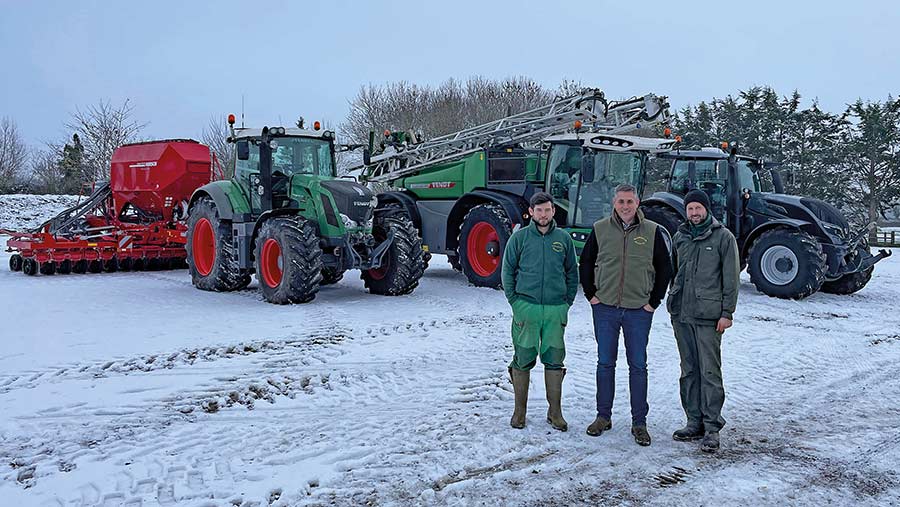 Matt Rose, Andrew Walters and Josh Bevan © James Andrews
Matt Rose, Andrew Walters and Josh Bevan © James Andrews The week’s edition of our What’s in Your Shed series delves into the mechanical ups and downs of Gloucestershire farm manager Andrew Walters.
Find out what his favourite machine is and what kit is helping him in a transition into direct drilling.
See also: Gloucestershire farmer builds £2k weed-crushing combine add-on
Farm facts: Boddington Estates, Gloucestershire
- Size 520ha
- Crops grown Winter wheat, winter oilseed rape, winter barley, winter beans, spring oats and grass
- Livestock 130 head of Pure Stabiliser cattle
- Soil type Mainly heavy clay loam
- Staff Andrew Walters, plus arable operator Matt Rose, stockman/estate worker Josh Bevan and a part-time administrator
How did you get started?
I grew up on a farm, but my agricultural career really started when I was fortunate to be offered an engineering apprenticeship with New Holland dealer Oakes Brothers, where I spent six years.
It was a good place to work, gave me a valuable qualification and was a great experience, but my heart was always in farming. So, when I was offered a job as head tractor driver on a local farm, I took it.
During my career I’ve been lucky enough to not only work for several very professional farms with great owners, but also farm managers who have given me the opportunity to progress.
It’s allowed me to work my way up through the ranks to my current position as farm and estate manager at Boddington Estates.
I arrived at Boddington in September 2014 and, since then, I’ve been working hard to improve soils and gradually move away from an intensive min-till system, to a more sustainable one that moves a lot less soil.
The ground here is a heavy clay loam, so careful management is crucial.
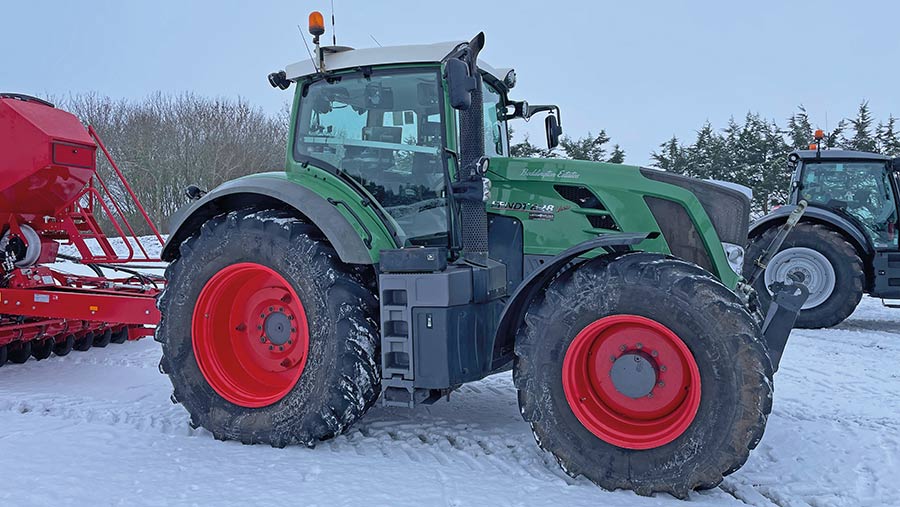
Fendt 828 © James Andrews
How brand loyal are you?
For many years, the estate was staunchly John Deere, but I’d got on well with Fendt tractors in the past and had a great relationship with Lister Wilder, which has since given up its Agco territory to Chandlers.
I also feel it’s important to give my operators input when purchasing kit, as they’re the ones spending the most hours on the seat.
When the time came to change one of the Deeres, it was decided that a Fendt 828 Vario would be the best fit, and it was a good move.
However, the next time we upgraded a tractor, we had a Valtra T-series on demo, which I had unfairly written off as a forestry tractor.
It pulled like a train and won us over to such an extent that we now have two of them.
Although the Fendt and Valtras have been great tractors and fulfilled our requirements well, recent dealer network changes have opened opportunities for other brands.
I am now very open minded and will be looking at all options available to us. I don’t think there’s a bad tractor out there these days.
Favourite dealer?
All our dealers have supported us well over the years, but most of them seem to be struggling with staff and that’s putting them under pressure.
We tend to buy new machines covered by warranty with the understanding that we’ll be up and running again quickly if there’s a problem.
If there isn’t anyone available when we’ve broken down at a busy time of year, it can rub me up the wrong way.
Having said that, we get on with all the engineers, who do their best to get us going – whether it’s over the phone or in the field. It’s not their fault if they’re spread too thinly.
As dealer groups get bigger, I hope it doesn’t have a negative effect on service. In theory, it should be better, but time will tell.
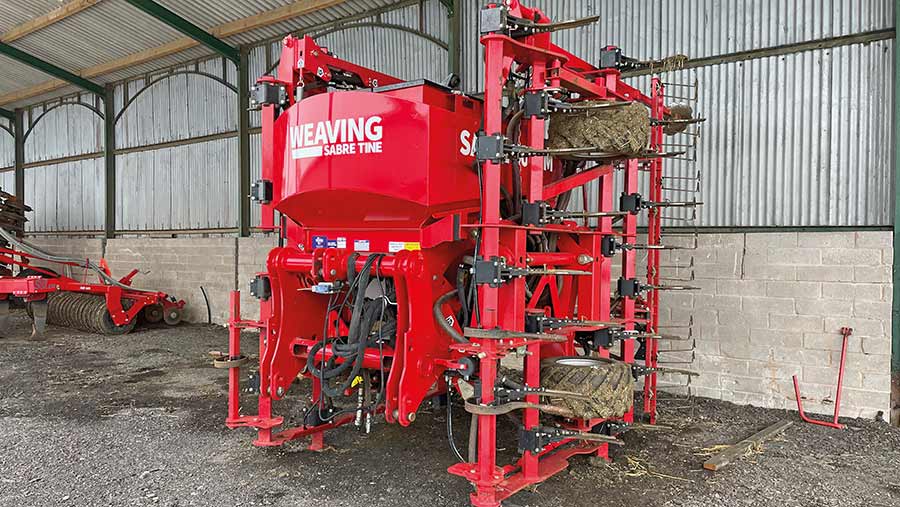
Weaving Sabre Tine drill © James Andrews
Favourite piece of kit?
For me, it’s the 6m Weaving Sabre Tine drill as it’s such a versatile piece of kit. We bought it after the wet autumn of 2019.
The Horsch Avatar does most of the cereal drilling, but the Sabre Tine will keep going when conditions get a bit sticky, or we want to move more soil. It’s also a fantastic bean drill.
On top of that, the service from Weaving is top notch.
Horsch Avatar drill © James Andrews
Least favourite?
The hydrovane compressor, as every time I get it out I know I’m going to get hot and covered in dust.
Latest purchase?
This year we made a big decision to invest in a 6m Horsch Avatar direct drill. It arrived in the autumn to replace a Vaderstad Rapid and is a key part of our transition into direct drilling.
Conditions this season were the kindest we’ve seen for years, which got the Avatar off to a good start and meant we could direct drill 90% of the farm with very good establishment.
The only work we did ahead of it was some low disturbance subsoiling where required.
However, we also carried out a contracting job drilling wheat on the frost in December for a local farm, which was a decent test to how far we can push direct drilling.
Conditions were fairly good and I was surprised how well it put the seed in. It will be interesting to see how it yields.
We specced the drill with three hoppers and a Mini Drill applicator on the rear with spreader plates, which gives plenty of options for experimenting with companion cropping and putting other products down in the same pass.
So far, I think it’s a great drill with huge potential.
Oldest piece of machinery still at work?
We’ve got a 1970s Parmiter three-phase grain elevator that’s invaluable when we’re tipping grain into our 1,200t low-roof store.
It’s almost impossible to lift a 16t trailer in there so we tip into the elevator, and it’ll empty the load in about 10 minutes.
Reliability is still good, and we replaced the elevator chains last year, which has given it a new lease of life.
How long do you keep your machines?
I work on a five-year replacement policy, but that’s more of a guideline than a hard-and-fast rule.
The tractors and combine are more likely to get swapped after seven or eight years when they have done 6,000-7,000 hours and don’t have any warranty left.
My goal is to get to a point where all mainline machinery costs are fixed and we can sell it on with a year of warranty left, which should help boost the second-hand value.
However, the way prices are going, this might just be a pipe dream.
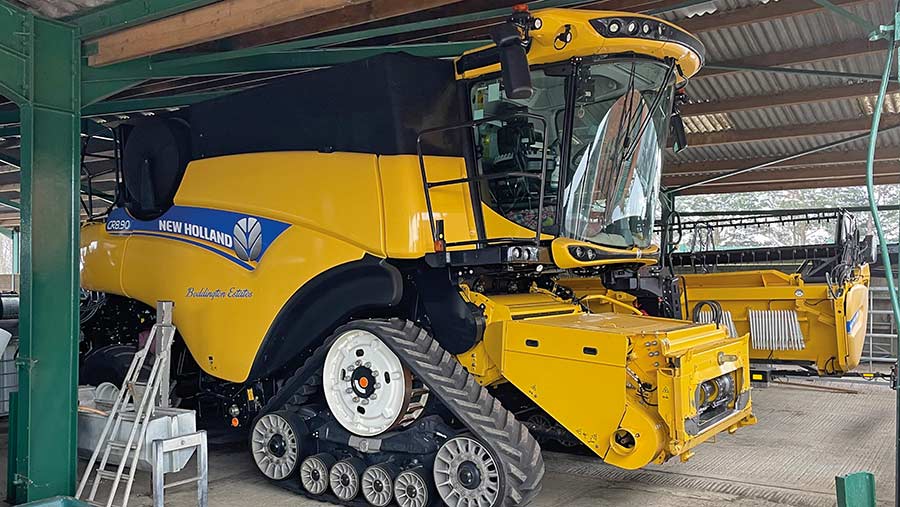
New Holland CR8.90 © James Andrews
What’s next on your wish list?
We’re looking at a potential replacement for our eight-year-old Fendt 828, which has been a great all-round tractor.
Figures are on the table from Fendt, Valtra, New Holland and John Deere, all of which are scarily high and hard to justify.
There isn’t much to split the Valtra, New Holland and John Deere when you compare the specs like-for-like. Prices all start with a two, which is hard to comprehend. As expected, the Fendt comes at a premium.
Goodness knows what it will cost to change our New Holland CR8.90 combine when the time comes.
Most embarrassing machinery mistake?
This season I had to do the walk of shame after rubbing the combine spout down an RSJ in the shed entrance while trying to avoid a plough I had stupidly parked in the way.
In my defence, I had a pair of eyes watching me, but the two-way radio was apparently turned off. It’s funny how everybody disappears when the boss hits something.
Although the damage could be rectified with a hammer, I decided I couldn’t bear to look at it for evermore, so a new tube and plastic boot was sourced and fitted by TH White at a cost of about £2,000.
Most expensive repair bill?
Every repair seems to be expensive these days. The fact that we’ve got good warranty on most equipment means we avoid the worst of the bills, but I dread the day something big fails when we’re not protected.
Most overpriced spare part?
A recent one that springs to mind is a turbo pipe for the Fendt 828, which cost an eye-watering £1,500. It’s a ridiculous price for what it was.
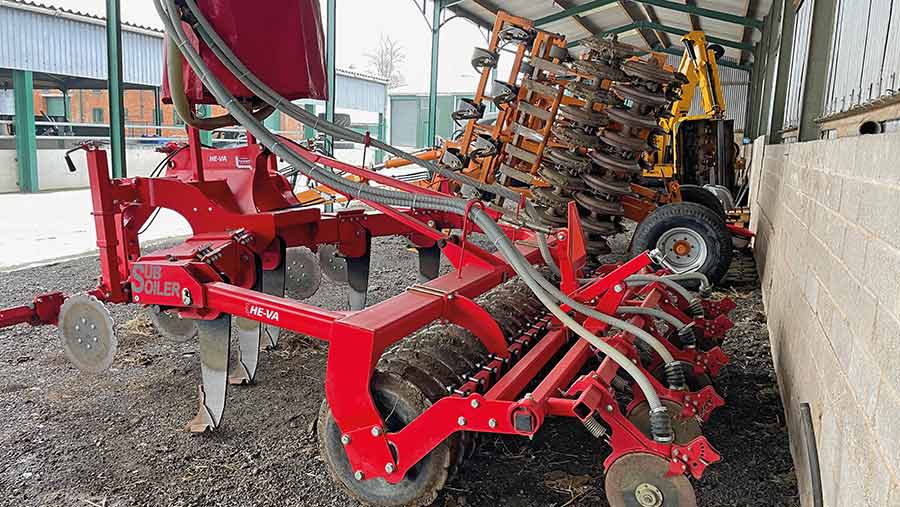
He-Va oilseed rape drill © James Andrews
Best invention?
I built an oilseed rape drill around our He-Va subsoiler using a Techneat applicator and Weaving double-disc coulters. I would have liked to use He-Va’s own discs, but they were just too expensive.
The drill works well, although I’d like to add extra hoppers for other applications.
What couldn’t you live without in the workshop?
The Milwaukee electric grease gun is high on the favourites list as it makes a tedious job almost effortless. Somehow, it never seems to pump air, and it’s the only grease gun I’ve had that I can say that about.
Do you buy second hand?
We mostly buy new equipment, but some is second-hand – it very much depends on what that piece of kit is going to do.
The most recent was a tidy five-furrow Kverneland plough that we got from TH White. Some years it won’t get hooked to a tractor, but it’s handy if we want to give a piece of ground a fresh start.
We also bought a smart 6,000-hour New Holland TS100 from Tallis Amos which runs our feeder wagon.
Favourite and least favourite job?
Drilling and combining are my favourites as they’re both satisfying when going well and they nicely bookend the season. Dryer cleaning has got to be the worst.
What’s your everyday transport?
I’ve got a 2017 Nissan Navara that replaced a Land Rover Discovery 3. I lost a bit of comfort in the switch, but gained some practicality.
It’s done about 35,000 miles and has been reliable enough mechanically, but I question its longevity as the chassis is already rusting. Dealer backup is also decidedly poor.
Best tractor you’ve ever had?
Back in the mid-1990s, I spent a lot of time in a Ford TW15, which was a brilliant tractor. It was the prime mover on the farm I worked on, and its main job was pulling a five-furrow Dowdeswell DP7 plough with press.
Power was about 135hp, which is nothing compared with what we’re running now, but it never felt underpowered and sounded fantastic. There was also very little to go wrong with it.
And the worst?
The worst tractor was a JCB Fastrac 165-55 which was plagued with electrical problems.
But the worst machine was a 2014 Househam Air Ride self-propelled sprayer that gave us no end of trouble.
Most of the issues were electrical faults and burst pipes, but the engine also failed, thankfully when it was still under warranty.
It went in 2019, and we replaced it with a Fendt Rogator, which has been brilliant. It’s a big machine, but it sits on large-diameter wheels with 620mm tyres all year and makes far less mess than the Househam did.
Thanks to its 5,000-litre tank and 36m boom we can cover the ground quickly and get the products on at their optimum timing.
Biggest machinery bargain?
I bought a Amazone Cayena drill from Lister Wilder a few years ago to put in some beans, which they let me have for a very keen price. It had been hanging around for years and I think they were glad to move it on.
Its popularity must have improved, as I traded it in for the Weaving Sabre Tine drill a few years later and made a tidy profit.
In the shed
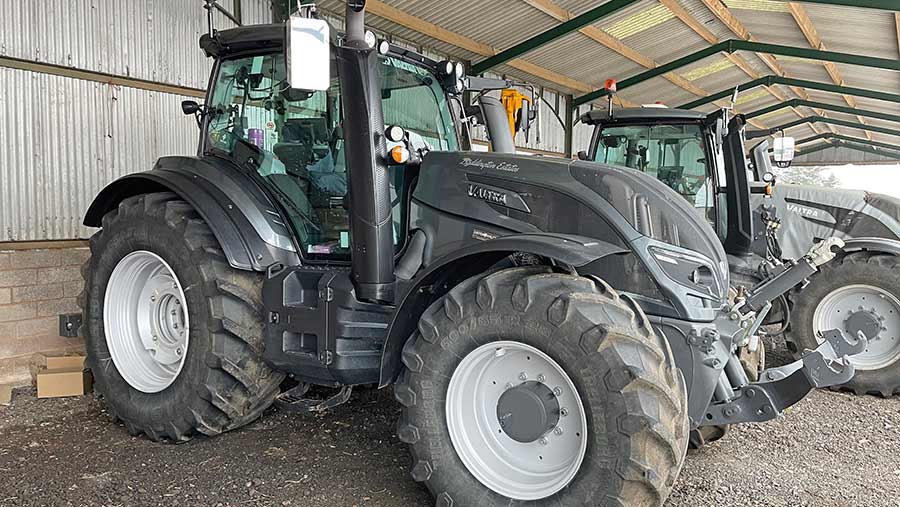
Valtra T234 © James Andrews
- Tractors Fendt 828, Valtra T234 Direct and T174 Versu with MX Q7 loader, New Holland TL100
- Combine New Holland CR8.90 with 30ft header
- Sprayer Fendt Rogator 635 with 5,000-litre tank and 36m boom
- Telehandler JCB TM320S
- Drills 6m Horsch Avatar triple hopper direct drill with Mini Drill mounted at rear, 6m Weaving Sabre Tine
- Cultivation kit 6m Horsch Joker, He-Va five-leg LD subsoiler, Proforge single-leg mole plough, 4.6m Simba Cultipress, Kverneland five-furrow plough, Dalbo 12.3m Maxi Rolls with cracker boards
- Fertiliser spreader Kuhn Axis 40.1
- Other Vegcraft 12,000-litre bowser, Ktwo 16t grain trailers x2, Warwick bale trailer, JF feeder wagon, McConnel 4.6m topper
